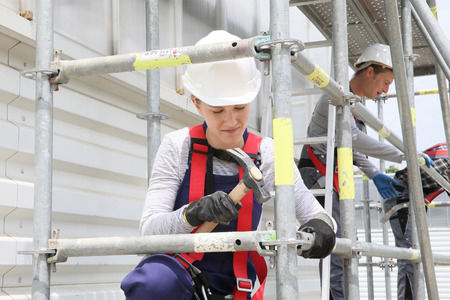22.B Scaffolds
Scaffolds (excludes Elevating Aerial Work Platforms). >See Section 22.L.
22.B.01 An AHA must be prepared by the contractor performing the work and submitted to the GDA prior to erection. The AHA will address all of the following elements, if applicable. If not applicable, reasoning must be provided.
- Site conditions (ground conditions, overhead utilities, etc.);
- Identity of specific type of scaffolding to be used;
- Scaffold dimensions to include height, width, depth and length;
- Load calculation for the anticipated work load and wind loading;
- The name of the Competent Person (CP) for Scaffolding, and
- The method of marking or barricading to be used per 22.B.21.
22.B.02 Erection, moving, dismantling, or altering of scaffolding must be under the supervision of a CP for Scaffolding.
- A CP for scaffolding must have a documented, minimum of 8-hours of scaffold training to include training on the specific type of scaffold being used (e.g. Mast-Climbing, Adjustable, Tubular Frame, etc.).
- The training must include:
- (1) Assessment of the base material the scaffold will be erected upon;
- (2) Load calculations for materials and personnel;
- (3) Erection and dismantling; or,
- (4) Training must meet the training requirements in the applicable ANSI standard. >See Section 21.B.04.
22.B.03 When scaffolding is in use, they will be inspected daily by the CP, prior to each shift. The inspection will be recorded on the daily safety inspection required by Section 01.A.13 and on the scaffold tag.
22.B.04 Scaffolding that has been hoisted after configuration or assembly must be re- inspected by a CP before initial use and again after each hoisting. This inspection will be documented on the scaffold inspection tag.
What is a Scaffold Tag?
22.B.05 A scaffold tagging system must be used. All scaffolds are tagged by the CP. Tags must:
- Include name and signature of the CP;
- Include dates of initial and all daily inspections;
- Be readily visible, legible, and made from materials that will withstand the elements;
- Include wording that states one of the following:
- (1) Scaffold is complete and safe to use;
- (2) Scaffold is incomplete, not ready for use and reasoning, or
- (3) Scaffold is incomplete and unsafe to use.
22.B.06 Anyone involved in erecting, disassembling, moving, operating, using, repairing, maintaining or inspecting a scaffold must be trained by a CP to recognize any hazards associated with the work in question. Proof of training must be maintained on site and made available to the GDA upon request.
22.B.07 Where persons are required to work or pass under a scaffold, a screen (consisting of No. 18 gauge US Standard wire 1/2 in (1.2 cm) mesh or the equivalent) must be provided between the toeboard and the guardrail and extending over the entire opening; or access to the potential impact area below must be restricted.
22.B.08 Capacities.
- Scaffolds and their components must meet the requirements contained in ANSI A10.8 or other applicable ANSI standard and be capable of supporting without failure at least 4 times the maximum anticipated load.
- Direct connections to roofs and floors, and counterweights used to balance adjustable suspension scaffolds, must be capable of resisting at least 4 times the tipping moment imposed by the scaffold operating at the rated load of the hoist, or 1.5 times (minimum) the tipping moment imposed by the scaffold operating at the stall load of the hoist, whichever is greater.
Knowledge Check Choose the best answer for the question.
22-2. How much load weight must scaffolds and their components be capable of supporting without failure?
You forgot to answer the question!

